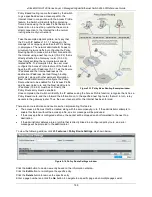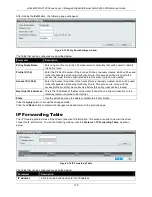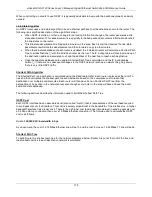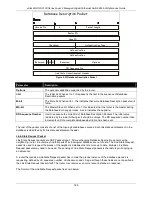
xStack® DGS-3120 Series Layer 3 Managed Gigabit Ethernet Switch Web UI Reference Guide
183
•
Two-way
- Bi-directional communication with a neighbor has been established. The router has seen its
address in the Hello packets coming from a neighbor. At the end of this stage the DR and BDR election
would have been done. At the end of the Two-way stage, routers will decide whether to proceed in building
an adjacency or not. The decision is based on whether one of the routers is a DR or a BDR or the link is a
point-to-point or virtual link.
•
Exstart
- (Exchange Start) Routers establish the initial sequence number that is going to be used in the
information exchange packets. The sequence number insures that routers always get the most recent
information. One router will become the primary and the other will become secondary. The primary router
will poll the secondary for information.
•
Exchange
- Routers will describe their entire link-state database by sending database description packets.
•
Loading
- The routers are finalizing the information exchange. Routers have link-state request list and a
link-state retransmission list. Any information that looks incomplete or outdated will be put on the request
list. Any update that is sent will be put on the retransmission list until it gets acknowledged.
•
Full
- The adjacency is now complete. The neighboring routers are fully adjacent. Adjacent routers will
have the same link-state database.
Adjacencies on Point-to-Point Interfaces
OSPF Routers that are linked using point-to-point interfaces (such as serial links) will always form adjacencies. The
concepts of DR and BDR are unnecessary.
OSPF Packet Formats
All OSPF packet types begin with a standard 24-byte header and there are five packet types. The header is
described first, and each packet type is described in a subsequent section.
All OSPF packets (except for Hello packets) forward link-state advertisements. Link-State Update packets, for
example, flood advertisements throughout the OSPF routing domain.
1. OSPF packet header
2. Hello packet
3. Database Description packet
4. Link-State Request packet
5. Link-State Update packet
6. Link-State Acknowledgment packet
OSPF Packet Header
Every OSPF packet is preceded by a common 24-byte header. This header contains the information necessary for
a receiving router to determine if the packet should be accepted for further processing.
The format of the OSPP packet header is shown below:
OSPF Packet Header
Type
Packet Length
Router ID
Area ID
Checksum
Authentication Type
Authentication
Authentication
Version No.
Figure 5-31 OSPF Packet Header Format
Summary of Contents for xStack DGS-3120 Series
Page 1: ......
















































